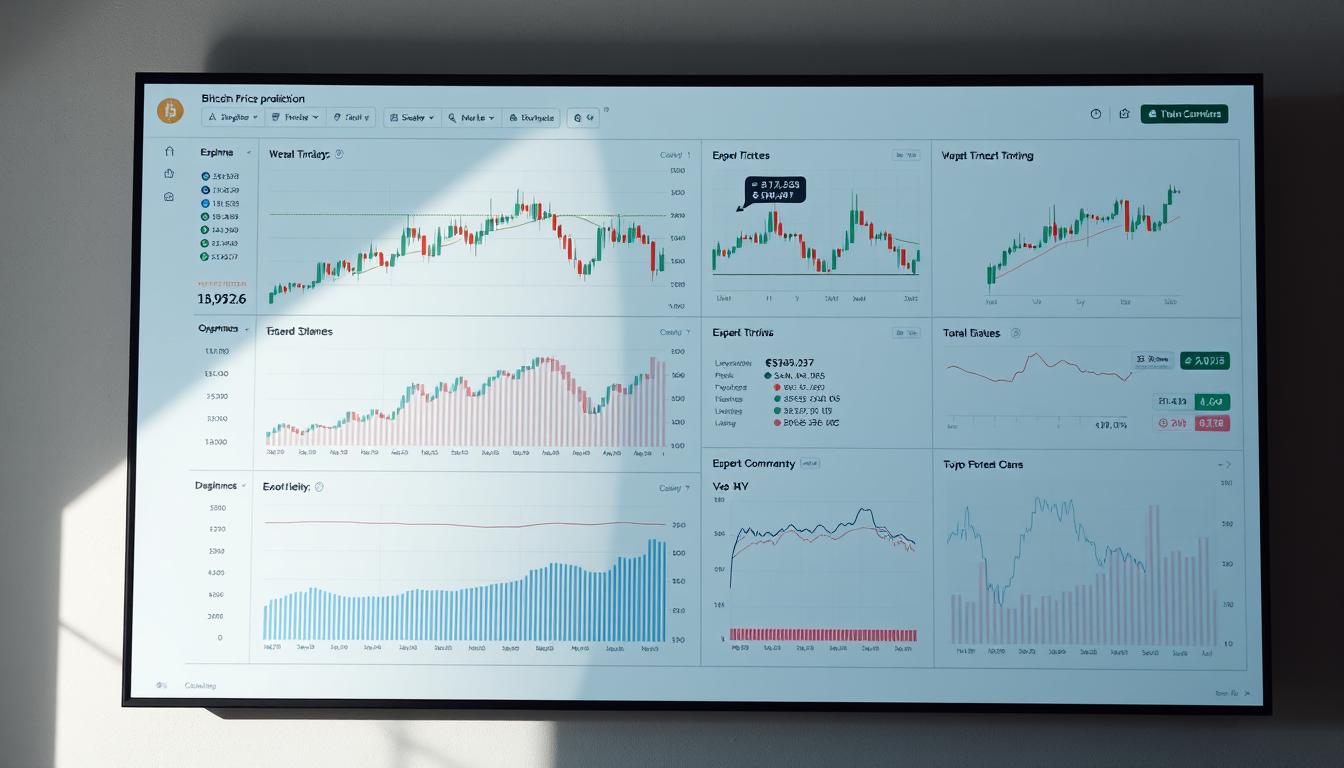Now Reading: Bitcoin All Time High Prediction: Expert Forecasts
- 01
Bitcoin All Time High Prediction: Expert Forecasts
Bitcoin All Time High Prediction: Expert Forecasts

The digital currency market continues to capture global attention as BTC maintains its dominant position. Currently trading at $111,119.00, this leading asset boasts a staggering market capitalization exceeding $2.2 trillion.
Recent performance shows strong bullish momentum with a $1,533.44 gain in just 24 hours. Over the past week, the asset has climbed 5.66%, indicating positive market trends heading into late 2025.
This analysis explores various forecasting methodologies that inform cryptocurrency valuation. We examine technical analysis, historical patterns, and expert opinions from leading financial institutions.
The comprehensive coverage includes multiple prediction models from premium forecasters and machine learning systems. Our research spans short-term outlooks through long-term projections.
Key factors influencing future price movements include regulatory developments and institutional adoption patterns. Understanding these elements provides valuable information for market participants.
Introduction to Bitcoin All Time High Prediction
Understanding digital asset valuation involves combining various analytical frameworks for reliable insights. This bitcoin price prediction analysis integrates multiple methodologies rather than relying on single indicators.
Recent cycles demonstrate this approach’s effectiveness. The forecasted consolidation from March 14th to April 13th proved accurate. A bullish trend then began precisely on May 10th as anticipated.
The current market positioning shows BTC entering a significant upward window between mid-October 2025 and early 2026. This aligns with established crypto cycle patterns observed over the past decade.
| Prediction Method | Primary Focus | Data Sources | Time Horizon |
|---|---|---|---|
| Technical Analysis | Price Patterns | Charts, Indicators | Short to Medium |
| On-Chain Metrics | Network Health | Blockchain Data | Medium to Long |
| Sentiment Analysis | Market Psychology | Social Media, News | Short Term |
| Cycle Analysis | Historical Patterns | Past Performance | Long Term |
The concept of confluence emerges when these diverse signals align. This creates higher-probability forecast scenarios for informed decision-making.
Most credible analysts expect new peaks before year-end 2025. Targets range from $125,000 to over $200,000 based on current institutional adoption curves.
Current Market Landscape and Technical Indicators
Real-time data indicates a market poised between consolidation and potential breakout movements. The current price sits at $111,119.00 with technical modeling projecting a 7.42% increase to $119,506.07 by late October.
Overview of Real-Time Price Data and Trends
Recent performance shows BTC experiencing 17 green days out of the last 30. This 57% positive ratio comes with relatively modest 4.85% volatility. Such conditions often precede significant market moves.
The four-hour chart displays bullish momentum with the 50-day moving average trending upward. This contrasts with the 200-day average’s decline since October 21st. This divergence creates interesting trading opportunities.
Key Technical Metrics and Sentiment Analysis
Current sentiment presents mixed signals that merit careful analysis. Technical indicators show 42% bullishness while the Fear & Greed Index registers 30. This fear reading often occurs before major upward trends.
Critical support rests near $108,000 with resistance at $120,500. Breaking this barrier could propel moves toward $130,000+. Today’s conditions mirror historical patterns observed before previous cycle peaks.
Historical Bitcoin Price Trends and Halving Events
Bitcoin’s journey from obscurity to global prominence reveals fascinating patterns in its price evolution. Understanding these historical movements provides essential context for current market analysis.
Evolution of Bitcoin Price Since 2010
The digital asset began with a valuation of just $0.003 in 2010. Early years saw dramatic shifts as awareness grew. By 2011, it reached parity with the US dollar.
Volatility characterized the 2012 period with values fluctuating between $5 and $13. The first major bull run occurred in 2013. Prices surged beyond $1,000 that year.
A significant correction followed in 2014 after the Mt. Gox collapse. Values dropped from $1,000 to below $400. This highlighted risks in centralized exchanges.
Recovery began in 2015 with stabilization around $200-$300. The 2016 halving event catalyzed movement above $700. This set the stage for historic gains.
The 2017 rally saw values approach $20,000. Retail interest and institutional curiosity drove this surge. A subsequent “crypto winter” brought values below $4,000 in 2018.
Recovery continued through 2019-2020 with prices exceeding $10,000. The May 2020 halving propelled values beyond $20,000 by year-end. Institutional adoption accelerated in 2021.
These patterns inform current bitcoin price prediction 2025 models. Historical cycles suggest potential for significant movement in coming years.
Impact of Bitcoin Halving on Price Dynamics
Every 210,000 blocks, Bitcoin’s protocol automatically cuts miner rewards in half, creating scarcity-driven price pressure. This scheduled reduction occurs approximately every four years. The mechanism directly impacts new coin supply entering the market.

Historical data reveals consistent patterns following these supply shocks. Each event has preceded substantial price appreciation over 12-18 months. The reduced issuance creates fundamental scarcity that drives valuation.
The current post-halving inflation rate sits at just 0.84%. This makes the digital asset scarcer than gold. Such conditions typically support upward price movement as demand meets constrained supply.
| Halving Event | Pre-Halving Price | Post-Halving Peak | Gain Percentage |
|---|---|---|---|
| November 2012 | $11 | $1,100 | 9,900% |
| July 2016 | $650 | $20,000 | 2,977% |
| May 2020 | $8,000 | $64,000 | 700% |
| April 2024 | $61,000 | $67,292* | 10.52% |
*Current price as of July 2024. The fourth halving’s full impact may still unfold through 2025-2026. Each cycle shows diminishing percentage gains but substantial absolute increases.
Institutional adoption combined with reduced supply creates favorable conditions for bitcoin price appreciation. The current market environment mirrors historical patterns observed before previous peaks.
Technical Analysis: Moving Averages and Volume Trends
Moving averages provide crucial insights into market momentum across different timeframes. These indicators help traders identify potential support and resistance levels. Current analysis reveals interesting dynamics between short-term and long-term trends.
Short-Term vs. Long-Term Moving Averages
The four-hour chart shows btc displaying bullish characteristics. The 50-day moving average is rising, indicating strong short-term momentum. However, the 200-day average has declined since October 21st.
Daily chart analysis presents a different picture. The 50-day moving average sits above the current price and continues rising. This configuration might create resistance for upward movements.
Weekly timeframe signals appear more consistently bullish. The 50-day average rests below the price and trends upward. This positioning often acts as dynamic support during uptrends.
Price Volatility and Trading Volume Insights
Recent trading activity shows moderate volatility at 4.85% over 30 days. This relatively calm period often precedes significant price movements. Volume patterns during this consolidation phase will be critical.
Market participants should watch for increasing volume on upward price moves. Such activity would confirm bullish conviction. The current price range between $108,000 and $120,000 represents a key decision zone.
These technical indicators suggest btc is building energy for its next major move. Careful monitoring of moving average crossovers and volume spikes will provide early signals.
Bitcoin all time high prediction
Multiple analytical approaches suggest a bullish trajectory for the premier digital asset. Expert consensus points toward significant appreciation through 2025.
The current bitcoin price prediction range spans $125,000 to $200,000. Most analysts cluster around $150,000 as a balanced target.
Several factors support this optimistic outlook. Sustained ETF inflows and institutional adoption create strong fundamental backing. Bullish technical patterns also indicate upward momentum.
| Forecast Scenario | Price Target | Probability | Key Drivers |
|---|---|---|---|
| Conservative | $125,000 | High | ETF growth, moderate adoption |
| Base Case | $150,000 | Medium-High | Current trends continuing |
| Bullish | $200,000 | Medium | Accelerated institutional uptake |
Critical support rests between $70,000 and $75,000. This zone represents the worst-case pullback scenario while maintaining the overall bullish structure.
Seven prominent experts surveyed share unanimous optimism. Their consensus btc projections align around the $200,000 value mark for 2025.
The overall outlook remains positive. Strong macroeconomic indicators and technical signals support continued upward movement through year-end.
Forecasting Models: Monte Carlo Simulation and Beyond
Portfolio theory has evolved to incorporate digital assets through innovative frameworks. The Nakamoto Portfolio Strategy helps investors understand how emerging technologies impact allocation decisions.
Nakamoto Portfolio Strategy Explained
This framework provides structured approaches for digital asset integration. It examines optimal percentage allocations and risk characteristics.
Monte Carlo simulations generate probabilistic btc price prediction scenarios. They run thousands of potential outcomes based on historical patterns.
| Simulation Metric | Value | Interpretation |
|---|---|---|
| Average Expected Price | $144,000 | Mean outcome after 1 year |
| 95% Confidence Range | $30,000-$448,000 | Most likely price zone |
| Worst Case Scenario | $6,500 | Minimum simulated value |
| Best Case Scenario | $901,000 | Maximum simulated value |
The wide range shows why single-point forecasts should be viewed skeptically. Extreme outcomes remain possible despite low probability.
Seventy-seven percent of simulations produce positive returns. This indicates favorable risk-reward dynamics for investment consideration.
The return-to-volatility ratio ranks among the best in any asset class. This analysis suggests strong potential despite price uncertainty.
Quantitative models cannot account for unprecedented regulatory changes. While valuable, they represent just one component of comprehensive investment analysis.
Expert Price Predictions for 2025
Quarterly forecasts reveal distinct trading ranges with varying return potentials for investors. Technical modeling suggests consistent movement throughout the final months of this year.

The baseline price prediction 2025 establishes a minimum of $113,245.54 with maximum reach of $119,345.02. Average trading value should settle near $125,444.50.
Key Forecast Ranges and Potential ROI Figures
Monthly projections show specific target zones with corresponding return calculations. Each period offers unique investment characteristics.
| Month | Minimum Price | Maximum Price | Potential ROI |
|---|---|---|---|
| October 2025 | $111,622.06 | $125,444.50 | 13.3% |
| November 2025 | $114,727.97 | $123,706.41 | 11.7% |
| December 2025 | $113,245.54 | $120,549.82 | 8.9% |
These figures represent conservative estimates within broader expert consensus. More aggressive price prediction 2025 models project higher values.
The projected ranges help investors plan entry points and position sizing. Understanding these price movements supports informed decision-making.
Insights from Renowned Forecasters and Analysts
Leading financial experts offer diverse perspectives on cryptocurrency valuation through unique analytical lenses. Their predictions span from conservative near-term targets to visionary long-term value projections.
Peter Brandt, Chamath Palihapitiya and Others
Legendary trader Peter Brandt recently revised his bitcoin price predictions upward to $200,000 by September 2025. This adjustment followed BTC breaking above a critical 15-month trading channel.
Venture capitalist Chamath Palihapitiya projects $500,000 by October 2025. He envisions the asset becoming a global reserve currency due to its decentralization and scarcity.
Max Keiser maintains an aggressive $200,000 forecast for 2025. The El Salvador advisor bases this on macroeconomic crisis scenarios.
Fidelity’s Jurrien Timmer applies Metcalfe’s Law to network growth. His model suggests $1 million per coin by 2030.
Bitcoin pioneer Hal Finney conducted a fascinating thought experiment in 2009. He calculated potential value based on global wealth distribution among 21 million coins.
These diverse predictions share a consistently bullish outlook. While price targets vary dramatically, the directional consensus remains positive for BTC appreciation.
The market benefits from multiple analytical frameworks. Each forecaster brings specialized methodology to their bitcoin price predictions.
Institutional Predictions and Market Adoption Trends
Wall Street’s embrace of digital assets represents a fundamental shift in institutional investment strategies. Bernstein analysts recently revised their predictions upward from $150,000 to $200,000 for 2025.

Spot ETF approvals in January 2024 transformed market dynamics. These products attracted approximately $15 billion in net flows. They may represent 7% of circulating btc supply by year-end.
Current ETF investor composition shows 80% coming from self-directed retail investors. Institutional integrations with wirehouses remain early-stage. This suggests significant upside potential for professional adoption.
Analysts project ETF assets could reach $190 billion by the 2025 peak. Long-term forecasts extend to $3 trillion by 2033. These figures indicate massive capital adoption over the coming decade.
BlackRock’s iShares Bitcoin Trust and Fidelity’s Wise Origin Fund dominate inflows. They bring institutional-grade infrastructure to crypto investment. This removes traditional barriers for large allocators.
The feedback loop between institutional adoption and price appreciation creates self-reinforcing cycles. As major financial firms develop btc services, mainstream acceptance accelerates dramatically.
These institutional predictions reflect growing confidence in the crypto market. The regulated exchange products provide accessible entry points for traditional investors.
Global Regulatory Environment and Its Impact
Global regulatory developments are creating new investment pathways for digital assets. The landmark SEC approval of spot ETFs on January 10, 2024, marked a pivotal shift in the United States market. This decision provided the regulatory clarity needed to accelerate institutional adoption.
Products like Fidelity’s Wise Origin Bitcoin Trust now offer regulated vehicles for professional investors. Analysts describe institutional basis trades as a “Trojan Horse” for broader adoption. These strategies allow large investors to cautiously evaluate long-term position building.
ETFs, Institutional Inflows, and Regulatory Changes
Current market composition shows nearly 80% of ETF flows originate from self-directed retail investors. Institutional integrations with major wirehouses remain in early stages. This suggests the wave of professional adoption has only just begun.
Anticipated approvals at major wirehouses in Q3 and Q4 would unlock access for high-net-worth clients. These developments would significantly alter market conditions and drive further growth.
International regulatory approaches vary dramatically. El Salvador’s embrace contrasts with China’s restrictions. These jurisdictional differences create unique growth trajectories for the crypto sector globally.
Balanced regulation reduces uncertainty and can accelerate exchange and protocol development. The evolving landscape continues to shape the digital asset position in the global financial system.
Comparative Analysis: Expert vs. Institutional Forecasts
Market projections vary considerably based on the analytical background and institutional perspective of the forecaster. This comparative analysis examines four distinct categories of bitcoin price predictions.

Premium crypto experts like Peter Brandt and Tone Vays project $200,000 targets for 2025. Their predictions acknowledge potential interim lows before ultimate upside resolution.
| Forecaster Category | 2025 Price Range | Key Representatives | Outlook Tone |
|---|---|---|---|
| Premium Crypto Experts | $200,000 | Brandt, Vays, Novogratz | Bullish with volatility |
| Crypto-Specialized Institutions | $125,000-$200,000 | Fidelity, VanEck, MicroStrategy | Unanimously bullish |
| Traditional Banks | Directionally positive | Standard Chartered, JPMorgan | Cautiously optimistic |
| Online Outlets | $100,000-$175,000 | CoinDCX, Coinpedia | Conservative bullish |
Financial institutions focused on digital assets show unanimous bullish sentiment. Their long-term btc price prediction models extend beyond $1 million based on adoption curves.
Traditional banks provide directionally positive predictions without specific targets. This reflects their more cautious approach to market valuation.
The striking consensus across all categories points toward substantial appreciation. Disagreement centers on magnitude rather than direction of price movement.
When independent experts, specialized institutions, and traditional analysts align bullishly, probability of significant upside increases dramatically for investors.
Long-Term Outlook: Price Predictions for 2026 and 2027
Extended forecasting models reveal intriguing patterns for the digital asset’s valuation trajectory through 2026 and 2027. These projections show expected consolidation followed by renewed bullish momentum.
Detailed Monthly and Yearly Forecasts
The 2026 outlook suggests relatively flat trading action. The minimum price sits around $100,075 with maximum near $100,006.
This represents an average trading value of $99,938. Monthly progression shows gradual decline throughout the year.
| Month 2026 | Minimum Price | Maximum Price | Trend Direction |
|---|---|---|---|
| January | $112,148 | $118,500 | Consolidation |
| June | $105,200 | $110,800 | Moderate decline |
| December | $100,075 | $100,006 | Stabilization |
The following year presents dramatically different conditions. The 2027 price prediction shows minimum expected at $283,081.
Maximum value could reach $342,171 with average trading near $291,256. This represents potential ROI exceeding 200%.
Monthly progression through 2027 shows consistent growth. January begins around $115,326 while December targets approach $283,081.
These multi-year projections align with historical cycle patterns. The consolidation phase in 2026 typically precedes major upward movements.
Investment strategy implications suggest accumulation opportunities during 2026. The subsequent year offers optimal holding conditions.
For comprehensive bitcoin price prediction analysis, consider multiple forecasting methodologies.
Future Price Scenarios: 2030 and Beyond
Looking beyond immediate forecasts reveals transformative potential for digital asset valuation. Extended price prediction 2030 models project extraordinary growth trajectories for the leading cryptocurrency.
The specific prediction 2030 shows minimum bitcoin price of $829,747 with maximum reaching $999,411. Average trading value should settle around $859,320.
This represents potential ROI exceeding 800% over the coming years. Monthly progression demonstrates sustained upward momentum throughout the decade.
| Month 2030 | Minimum Price | Maximum Price |
|---|---|---|
| January | $592,288 | $729,718 |
| June | $700,224 | $852,306 |
| December | $829,747 | $999,411 |
Major institutions project even more ambitious targets. Fidelity forecasts $1 billion per unit by 2038-2040 based on network growth models.
VanEck maintains a $1 million long-term target while Pantera Capital predicts $740,000 by 2028. These projections reflect confidence in cryptocurrency adoption.
Fixed supply and increasing global usage support these extended price scenarios. The digital asset’s potential as a reserve currency drives optimistic prediction 2030 models.
While uncertainties remain across multiple years, the consensus points toward significant value appreciation for this pioneering crypto asset.
Market Sentiment, Risks, and Potential ROI
Investors navigating today’s digital asset environment must balance promising ROI potential with measured risk evaluation. Current market conditions show a fascinating divergence between technical indicators and emotional readings.
The Fear & Greed Index registers 30, indicating fear dominates current sentiment. This contrasts with 42% bullish technical signals. Such mixed emotional states often precede significant bitcoin price movements.
Risk Assessment and Fundamental Considerations
Credible downside scenarios project potential prices dropping to $70,000-$75,000 if key support levels fail. This represents manageable risk compared to upside targets exceeding $200,000.
Extreme stress-test models from Tyler Richey and 10X Research identify $55,000-$57,000 as worst-case lows. However, these represent low-probability tail-risk outcomes during severe macroeconomic downturns.
Peter Brandt assigns just 25% probability to deep pullback scenarios. This quantitative framework helps investors assess risk-reward ratios when considering investment position sizing.
Even conservative forecasts suggest double-digit returns, while aggressive cases project triple-digit gains. This creates favorable asymmetric risk-reward profiles for long-term investment strategies.
Fundamental risks include regulatory changes, technological vulnerabilities, and macroeconomic shifts. These factors could significantly impact future prices outside predicted ranges.
Practical risk management involves monitoring support levels and maintaining diversification. A long-term perspective remains crucial when dealing with volatile assets experiencing dramatic price swings.
Conclusion
Synthesizing the comprehensive research reveals compelling evidence supporting optimistic market projections. The bitcoin price prediction for 2025 maintains a bullish stance across multiple analytical frameworks.
Consensus forecasts cluster around $150,000 with potential reaching $200,000. This digital asset enters its next favorable window between mid-October 2025 and early 2026.
Quantitative models provide strong support for this outlook. Monte Carlo simulations show 77% of scenarios generating positive returns. The risk-adjusted return profile ranks among the best in any asset class.
This information helps investors make informed decisions aligned with their risk tolerance. While short-term price movements may fluctuate, the long-term growth trajectory appears well-supported by fundamental adoption trends.













